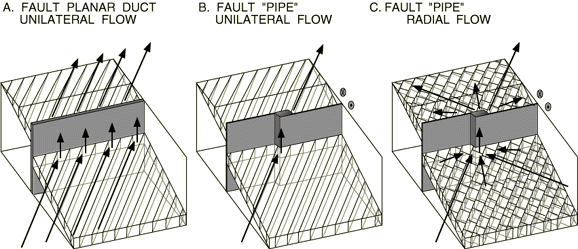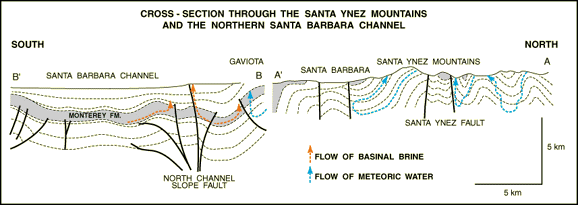| Paleo-Hydrology of the Miocene Monterey Formation, Coastal California--The Role of Faults on Basin-Scale Fluid Flow |
| Faults in convergent plate boundary settings have been observed to act as preferred conduits for fluid flow. In contrast, fluid flow along fault zones in transcurrent regimes such as the San Andreas fault in California and the role of fluids on earthquake behavior along these faults are poorly understood. In addition, it has been recognized that faults can be both conduits and barriers in petroleum systems but predicition of the effect of faults on basinal fluid flow is qualitative and limited to some first-order effects. To address the role of faults on basin-scale fluid flow we studied paleo-fluid flow along faults in the Monterey Formation, an organic-rich sequence of siliceous mud- and dolostone deposited during Miocene times along the California margin. The formation is source and fractured reservoir of hydrocarbons, with typically low matrix but high fracture permeability. Faults exposed and cored in the Santa Barbara coastal area are locally cemented by large quantities of carbonate and minor silica cement. We combined structural and geochemical observations, including strontium and stable isotopic analyses and fluid inclusion microthermometry, with textural observations and mass balance calculations to infer the scale and dynamics of fluid flow along these faults. Using the strontium isotopic composition of carbonate fault cement as a natural tracer for fluid flow, we estimated the distance of fluid flow across bedding (cross-stratigraphic flow distance) along two steeply inclined faults to be a few hundred meters, similar to or less than the stratigraphic thickness of the Monterey Formation at these locations. Combining these estimates of cross-stratigraphic flow distance with mass balance calculations of fluid required to precipitate the observed amounts of fault cement we derived the distance of formation-parallel distance of flow toward one of these faults. The ratio of formation-parallel flow distance over the cross-stratigraphic flow distance can be considered a measure of fluid focusing, quantifying the extent to which a fault affects basin-scale fluid expulsion. We estimated this ratio to be in excess of 6:1, suggesting that faults are highly effective in channeling fluid expulsion from the Monterey Formation to higher stratigraphic levels and to the surface. The mass balance calculations also indicated that fluid is not only focused toward these faults by bedding-parallel flow but also radially toward high-permeability fault segments or 'fault pipes' such as releasing fault bends and step-overs. As illustrated in Figure 1, radial flow in fractured rocks along bedding toward fault pipes requires at least two connected and crosscutting fracture sets for fluid flow along fault pipes to be effective. |
 |
| Figure 1. Interplay between fault permeability structure and fracture permeability in the surrounding formation, controlling the effectiveness of fluid expulsion along fault conduits. After Eichhubl and Boles, 2000b. Based on the inferred fluid composition using fluid inclusion and cement isotopic data, in combination with compositional analyses of modern formation fluids from producing oil wells, we distinguished two distinct hydrologic regimes in the Santa Barbara basin. Diagenetically altered connate fluid in the basin is likely to be expelled by a combination of diagenetic fluid release and porosity loss. The adjacent Santa Ynez Mountains host a topographically driven meteoric recharge system. Both systems appear to be separated along faults (Figure 2). |
 |
| Figure 2. Hydrologic regimes in the Santa Barbara basin and the adjacent Santa Ynez Mountains. A second part of the project assessed rates of fluid flow in one of these fault systems based on heat transport considerations and the inferred transport of fault breccia fragments by fluidization. Inferred rates of fluid flow were as high as 1 m/s, interpreted as co-seismic pulses of fluid flow during seismic slip of this and other nearby faults. To our knowledge, this estimate was the first attempt in quantifying rates of seismically induced fluid flow within a fault conduit. Publications
last update: 10/31/00 |